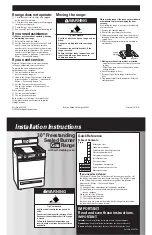
Operating Instructions Ascoline 850, MGH 2xx, 4xx, 6xx
ascobloc
Gastro-Gerätebau GmbH
01156 Dresden, Grüner Weg 29
Germany
Tel.: +49 351 4533-0
Fax: +49 351 4533 433
E-mail:
,
MGH2XX.doc, Edition: 20.03.2008
Subject to change without notice!
3
If the appliance is to be shut down: First put all gas valves to "Off" and then close the gas supply valve
within the customer's extent of supply. This applies also in the case of repair work.
Appliance with gas-fired roasting and baking oven
It must be checked and made sure that the flue gas path of the oven is not obstructed by foreign bodies
or constricted in any way. Only operate the oven with the door closed.
Appliance with electric roasting and baking oven
Before repair work is started, the equipment must be disconnected on all poles from the power (using
isolating equipment in the customer's supply, e. g. fuses).
3.3 Instructions for transport
Transport ascobloc equipment only in the original packaging. This avoids unnecessary damage and
expense.
Check equipment for damage.
Do not lift or shift the appliance by holding the top plate, the bottom edges at the sides of the appliance or
by the door handles. The bottom edges at the front and rear of the appliance are provided for this.
4 Installation
The manufacturer cannot be made liable for damage due to inexpert transport and installation. Claims
made under the guarantee in such cases are also invalid.
Gas transporting elements and electrically live components may only be installed, replaced or modified by
authorised specialist staff.
The appliance must be set up in a well-ventilated room, if possible under an extraction hood (see DVGW
Worksheet G 634).
The technical data for electricity and gas are to be found on the type plate on the front panel (A) (see data
sheet).
4.1 Setting up
Do not set up the equipment next to walls, kitchen furniture, and decorations or similar which are made of
flammable materials. Otherwise there is danger of fire. See connection diagram with equipment
description for minimum distance. Local fire protection regulations must be kept to absolutely!
It is of importance that the equipment be set up absolutely horizontal (use spirit level for alignment) so
that the doors can be opened and closed without any problem and that they seal tightly when closed.
Equipment with adjustable feet can easily compensate for unevenness in the floor (+/- 20 mm) by turning
the bottom ends of the feet. If set up on a plinth, this is to have an underlay if needed.
4.1.1 Free-standing set-up
If the equipment is to be set up on its own, suitable means are to be used to protect it against tilting and
shifting.
4.1.2 Setting them up in groups or blocks
When setting up in groups or blocks, the equipment must be joined together by connecting elements
provided for this purpose. This is for the sake of hygiene. Observe equipment setting up sheets or
assembly diagram (data sheet in annex).
4.2 Connections
Details of connections for the media can be taken from the accompanying connection diagram and
equipment description. Check whether the size and position of the electrical connections of the customer
side correspond to the information in the connection plan, equipment description or installation plan
The terminal box for the connections is located behind the front panel A (see data sheet). Make the
connections as shown in the annex or in the connection diagram accompanying the equipment. The
number of the connection diagram is to be found on the type plate. Once the electrical connections have
been made, close the cover of the terminal box and screw the front panel in place again
The connections can be made from below or from the rear from a closed installation space. With the
connection from below, the pipe length must be 50 mm above the floor surface.
You can get the necessary technical data about the type of gas and its pressure from your gas supply
utility.
4.2.1 Gas type, connection pressure
The appliance is set up in the factory for the type and category of gas noted on the type plate of the
appliance. The type of gas and the supply pressure must match the gas setting given on the appliance. If
not, a conversion or adaptation of the appliance must be made to suit the local conditions (see
conversion instructions).
































